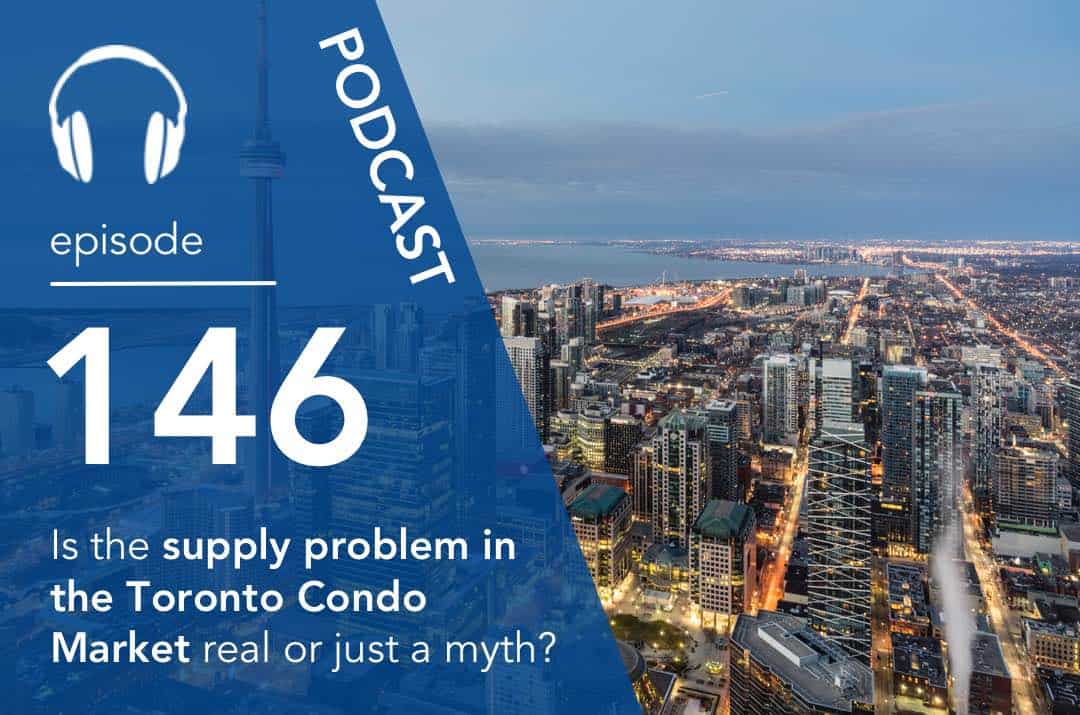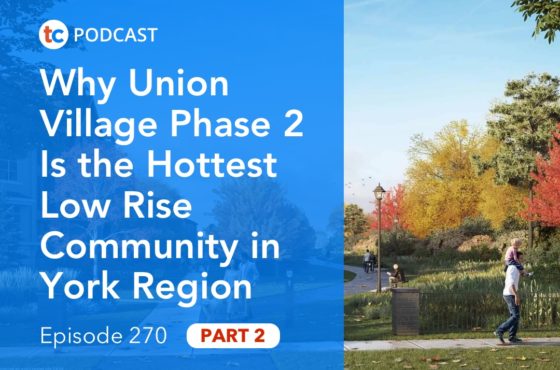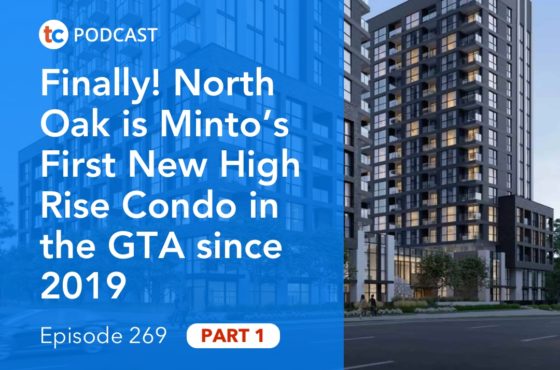Is the supply problem in the Toronto Condo Market real or just a myth?

Is there a supply problem in the Toronto condo market or is it just a myth? Recently an article in Globe and Mail suggested that we don’t actually have a supply problem but we have a lack of government intervention problem. In this episode, Andrew la Fleur takes a look at the supply side of the equation and answers the question of what would it take to actually slow the market down and to stop prices from rising so quickly as they are now?
EPISODE HIGHLIGHTS
2:00 Problems with the government intervention.
4:08 Affordability problem.
4:47 Supply Problem.
7:55 How the housing markets are all interconnected.
12:50 Dealing with the supply problem.
Click Here for Episode Transcript
Andrew: Is there a supply problem in the GTA housing market, and that’s why prices keep rising? Or is that just a myth put out by the housing industry? Find out on today’s episode.
Announcer: Welcome to the True Condos Podcast with Andrew la Fleur. The place to get the truth on the Toronto condo market, and condo investing in Toronto.
Andrew: Well good morning, good afternoon, or good evening; whenever you’re listening to this podcast. Thank you for listening once again. It’s Andrew la Fleur from True Condos, and I appreciate your support for this show.
As I mentioned in the intro, I want to talk about the supply question today. The reason for this podcast is, there was an article in the Globe And Mail; an opinion piece written by Gary Mason in the Globe And Mail. I must confess, I don’t know who Gary Mason is. I believe he’s just a reporter or an opinion writer for the Globe And Mail. But, nevertheless, Mr. Mason, his headline is “Sky-High Condo Prices Aren’t A Supply Problem”. Obviously that ruffled a few feathers within the housing industry. A lot of people are posting this on social media. If you follow people within the housing industry on Twitter, Facebook, and so on, you might have seen this pop up on your feed.
A lot of people are saying that they disagree with this article, so I wanted to dive into it a little bit here and tell you what I think about the subject at hand, which is a supply question. Basically, in his article, to summarize it, he’s basically saying that, more or less, he’s saying that there’s not a problem with supply in the housing market. He believes the problem is with government intervention or lack thereof. He seems to be pushing for the solution in his mind, for the problem of affordability and lack of affordable housing in Toronto and Vancouver especially, is more government intervention. He’s saying the government continues to let us down. He’s saying that this idea that it’s a supply issue is basically a myth put forward by the housing industry.
He’s saying, “Look around.” I believe he’s Vancouver-based. He’s using examples in Vancouver. He’s saying, “Look around Vancouver and you can buy … There’s condos going up everywhere and you can buy them. Look, here’s one starting at $1.7 million. Here’s a two-bedroom for $1.5 million.” He’s basically saying that the prices are just out of control. And the developers who are saying new supply is going to solve it, he’s saying, “No, look at the new supply that’s coming out. It’s so expensive. It’s not going to solve anything.” And he goes into this foreign buyer thing.
This was a bit of a surprise. He’s, once again, harping in on this much talked about, and has proven to be false so many times, he’s saying that foreign investment is driving up prices; that foreigners are coming in and buying huge amounts of pre-construction condos, and they’re flipping them for profits. Or, he says they’re hanging onto them as safe investments and renting them out. Well, if that is a crime, then lock me up, because buying a condo and renting it out as an investment, what a concept.
Anyways, I definitely disagree with the main thrust of the article. He’s got some points that are certainly valid, the main point being, there is an affordability problem. We can all agree on that; that it is becoming a very expensive city to live in in Toronto. Although I don’t know the Vancouver market intimately, from what I understand it’s a very similar problem there as well, if not more so, because price points are higher, and average income is, from what I understand, is lower in Vancouver and area compared to Toronto. Certainly it’s a much smaller city with much smaller job pools.
Here’s a few points that I wanted to bring up on this subject and give you my take on it. Number one is, we do have a supply problem. Absolutely no question, we do have a supply problem. It’s plain to see. All you have to do is look at the numbers. The numbers don’t lie. Every year it seems to be getting worse. We have fewer and fewer properties available for sale. If you look at the new construction low-rise market, we’ve got a handful of properties available for purchase in the GTA, versus 10 years ago we had tens of thousands of them. The available supply on the new low-rise side has dropped off like a cliff over the past 10 years or so. We have a major lack of supply compared to years past in the low-rise housing market, new construction housing market.
If you look at the high-rise market, new construction high-rise market, it’s a similar story. Although we are building and launching and releasing more high-rise condos than ever before, and the trend is certainly moving upwards with, year after year, building more and more high-rise condos. The standing inventory, the amount available for sale, is at something like a 10-year low right now. Basically, everything that has been launched in the last two or three years, everything is sold out. New projects that are coming out today, as you know if you’ve been following me or this podcast or my emails for any amount of time, you know that over the past six to 12 months, projects are selling out overnight; entire projects: 300, 400, 500, in some cases 1,000 units, are selling out within days.
This just continues to exacerbate the supply problem where there’s, you know, normally a project would sell out 30%, 50% in the first launch period, and then it would take several months, or even a couple of years for them to sell the remainder, and so that inventory would be available out in the market for anyone to come and purchase. But all that inventory that is usually there is gone, because it’s disappearing at launch. It’s disappearing within those first few days, so there’s nothing to buy. That is a big problem. Supply is low. Again, supply and demand, economics 101, prices keep rising.
There’s really no question. We do have a supply problem. You look at the resale market, it’s the same story. We have far fewer properties available. Then if you look at the condo market right now, we have far fewer properties available today than there were a year ago or two years ago and so on. That’s today. That’s the market today. We definitely have a supply issue. It is a seller’s market. The balance of power is definitely with sellers right now still, and we just do not have enough product out there to buy. That’s the first point. We definitely have a supply problem.
Number two, the housing market is interconnected. This is, again, something we talk about a lot on the podcast. It’s critical to understanding the economics and the reality of housing. You have to understand that everything is connected. The fatal flaw of so many analysts who look at the market, or articles that you see in the media, headlines that you see in the media, is that they are just usually, and often, focused on just one segment of the market and drawing conclusion based on one segment. But you have to understand that all the segments of the market are connected: low-rise, high-rise, and the rental market. Everything is connected to each other, and they’re all … You do one in one thing, it’s going to have repercussions in the other area, and so on.
Again, when you look at the mix of new housing that is being built. 10 years ago, you would have, say, three new low-rise homes in the GTA built for every one new condo built; approximately three to 1. Now today, 10 years later, that number has completely been flipped on its head. Now you have approximately three high-rise condos built for every one low-rise house that’s built. When somebody says, just the basic example, when somebody says, “There are too many condos being built.” Or, “Look at all the cranes everywhere. This is all going to crash. It’s a bubble. There’s too many condos, too many condos.” Well, again, condos are just one piece of the overall housing market. How many houses are being built? Well, if we told you that house construction was down 80% from what it was 10 years ago, then it would make a lot more sense why high-rise construction has increased over the years. The amount of total homes available: houses and condos available today, is not all that different from what it was 10 years ago, and so on.
The market has simply flipped. A big reason for the flip was, in 2005, the Places To Grow Act came into place, the greenbelt came into place around the GTA, severely limiting and restricting sprawl, and land available for development in the Golden Horseshoe, and so we have … And also just public policy in the Places To Grow Act encourages urban high-rise intensive, dense development, as opposed to sprawl, and continuing to spread further and further out, which is basically what happened non-stop and unabated from the 1950s, ’60s, right up until, really, until 2005 when this legislation came into play. So the housing market is interconnected.
You’ve also got to look at the rental market as well. You could make conclusions about where the market is going based on what you see in the low-rise market or the high-rise market. You also have to take into account the rental market. People have to live somewhere. They’re either going to buy, or they’re going to rent. That is a decision that everyone has to first make, “Am I buying or renting?” Then they go and they find housing. You can’t look at just the sales without looking at the rentals as well. If you look at what’s happening in the rental market right now, rental prices are up approximately 9% or 10% year over year right now for condos in the city. Rental prices are rising as well as resale and new houses and condo prices.
So as a person looking for housing, where are you going to go? Rents are rising, resale prices are rising, new construction prices are rising. All these things are pointing to one simple solution, and that is, we’re not building enough new housing. We are a region that’s growing, and we’re growing quickly, and we’re just not keeping up with the growth, and so we need more housing. Again, we have a supply problem. When all segments of the market are rising including the rentals, then it’s pretty clear what’s happening here, is we have a supply problem. We are not building enough.
That was my second point. Housing markets are all interconnected. You have to look at them together. Going back to the first point, we do have a supply problem. Now, my final point that I want to bring up about this is, the solution is supply, but, unfortunately, we can’t rush the solution. What I mean by that is, yes, we do have a supply problem. Yes, the answer is more supply. But unfortunately, there’s no magic bullet. You can’t just snap your fingers and make new supply. Even if overnight the government said, “You know what? The greenbelt thing, it was a bad idea. We’re just going to get rid of the whole greenbelt; free-for-all. Developers, build anywhere you want.” It would still take at least two or three years. Even in that extreme scenario that’s not going to even happen, it would still take two or three years for the new supply to actually come on stream and to have an effect on the market in a material sense to actually have so much new supply that prices would actually begin to level out or fall with any significance.
There’s natural ebbs and flows in every market. Right now we are in a sort of natural, slowing down state. In the resell market we’re seeing it. Since around April the 1st, end of March, we’ve seen an increase of supply. As prices have risen so dramatically over the past year, finally a lot of people are starting to say, “You know what? This property that I’ve been sitting on, it’s time to sell.” You’re seeing more and more people cashing in on the massive gains that have happened in their properties over the past year, more supply is coming on stream, and things are starting to slow down, at least in the resale market. It’s still certainly a seller’s market, definitely not a buyer’s market. But things are very different now than they were. A lot of it, again, is just affordability. Prices have gone up so much that you’ve sucked a lot of buyers out of the system. But again, where do those buyers go? They go back to renting, or they stay where they are and they don’t sell.
All these things are interconnected. At the end of the day, there’s not going to be any significant change in the market unless something dramatic happens, either on the supply side of the equation, or the demand side of the equation. Like this author was saying in this article, he’s basically calling the government out to do something about it. There’s only so much the government can do, even if the government looks at raising interest rates.
We’ve been talking about that for years. It doesn’t look like interest rates are going to be raised anytime soon. For the past, I’d say seven or eight years, it’s always, “Next year. Next year. End of next year. End of next year. Beginning of next year.” It’s always, you know, “Get ready for interest rate increases.” They’ve been saying that for, again, almost a decade now; is, “Get ready for interest rate increases.” The reality is, the government has so much debt accumulated that it just doesn’t make any sense for them to raise interest rates, because they, you know, you talk about our mortgages and things that we have to pay off, well, look at the government. We are the government, it’s our money. Look at the debt that the government has accumulated and built up, and is continuing to increase. Do you think they have any incentive to raise interest rates when they’re sitting on the biggest pile of debt that they’ve ever sat on in our country’s history? Of course not. It makes no sense.
It’s in their best interest to keep interest rates low. It’s just sort of this conundrum that we’re in where interest rates could very well stay at this level, you could make an argument, for decades to come. Sure, they might go up a quarter-point here or there, but in terms of going up two, three percentage points, I personally just don’t see that happening. I don’t see that happening any time in the next several years, we’ll say. You could make an argument that, for decades to come, the interest rates will stay low.
I think the only thing that’s really going to change the market, and it’s something I’ve said time and time again, is if there’s a massive interest rate increase, which would curb demand, or if there’s some kind of a recession. Of course, when there’s a recession, when people are losing their jobs, that will obviously have an effect on the housing market and slow things down. But all things are seemingly pointing in the opposite direction right now, that we are in a period of growth coming out of a long period of post-recessionary, flat market, and flat growth; very slow growth. The signs are, if you look at what’s happened in the US especially, signs are pointing towards, we’re in for a period of growth economically over the next several years. But of course, nobody has a crystal ball. We’ll see what happens there.
So either interest rates, a recession, or some kind of dramatic supply-side change. That’s the only thing that’s going to change the market. But again, there is no dramatic supply-side change. Like I said, if you erase the greenbelt, or something like that, it would take years, at least two or three years before any kind of supply side of the equation change would have an impact on the market.
Okay, there you go. I’ve blabbed on enough about this subject for today. I hope you’ve found some of this podcast today, or maybe all of it, in a perfect world, interesting and useful to you. If you did, if you could go ahead and share this with somebody that you know who you think would benefit from this podcast, today’s episode, or any of the episodes, I would really appreciate that.
Okay, until next time! I hope you have a great week. Thanks for listening, and make sure you do subscribe at TrueCondos.com. Drop your email in anywhere on the site and make sure you’re up-to-date on all of the condo investments that are happening here in Toronto. Thank you. Talk to you soon.
Announcer: Thanks for listening to the True Condo Podcast. Remember, your positive reviews make a big difference to the show. To learn more about condo investing, become a True Condo subscriber by visiting TrueCondos.com.



